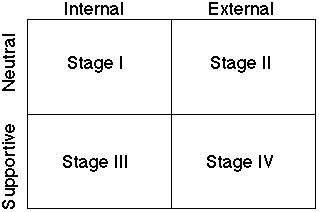Capability and Maturity - Hayes and Wheelwright's Four Stages
Hayes and Wheelwright describe four stages of manufacturing
competitiveness:

Stage I
Stage I companies consider their manufacturing organisation
to be internally neutral, in that its role is simply to "make
the stuff", without any surprises. Such companies believe
that their product designs are so unusual or their marketing
organisation so powerful that if the product can simply be delivered
to customers, as advertised, the company will be successful.
Stage II
Stage II companies look outward and ask their manufacturing
organisation to be externally neutral, that is, able to meet
the standards imposed by their major competitors. Such companies
tend to adhere to industry practice and industry standards. They
buy their parts, materials and production equipment from the
same suppliers that their competitors use, follow similar approaches
to quality and inventory control, establish similar relationships
with their workforce, and regard technicians and managers as
interchangeable parts - hiring both, as needed, from other companies
in the industry.
Stage III
Stage III companies have a manufacturing organisation that
is internally supportive of other parts of the company, with
a co-ordinated set of manufacturing structural and infrastructural
decisions tailored to their specific competitive strategy.
Stage IV
Stage IV companies regard their manufacturing organisation
as externally supportive, that is, playing a key role in helping
the whole company achieve an edge over its competitors. Such
companies are not content simply to copy their competitors, or
even to be the "toughest kid on the block" in their
own neighbourhood. They seek to be as good as anybody in the
world at the things they have chosen to be good at - that is,
world-class.
Reference
- Hayes, Robert H., and Wheelwright, Steven C., "Restoring
Our Competitive Edge: Competing Through Manufacturing".
New York: John Wiley, 1984.
|